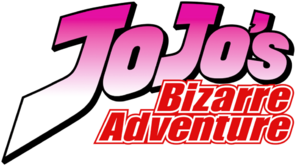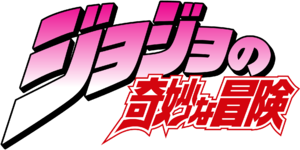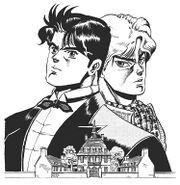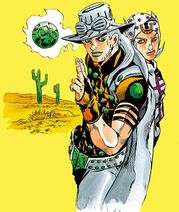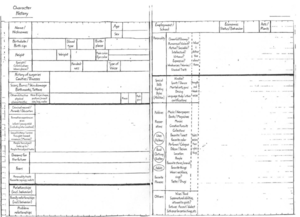JoJo's Bizarre Adventure
JoJo's Bizarre Adventure (ジョジョの奇妙な冒険, JoJo no Kimyō na Bōken), often shortened to JoJo or abbreviated as JJBA, is a shonen and seinen manga written and illustrated by Hirohiko Araki, and is the main subject of this wiki project.
Profile
JoJo was serialized in Weekly Shonen Jump from 1986[3] to 2004, when it transferred to the monthly seinen magazine Ultra Jump, where it continues to be serialized. The series is collected in a variety of formats ranging from standard tankōbon and paperback volumes to special editions such as hardcover "JoJoniums" and omnibuses, all of which contain the manga as it was serialized in Weekly Shonen Jump and Ultra Jump, albeit with differences in chapter names and slight dialogue adjustments.
The series has over 120 million copies in print,[4] making it one of the best-selling manga series in history. Filling over 130 volumes, it is Shueisha's second longest-running manga series after Golgo 13.
JoJo's genre spans Action, Adventure, Supernatural, Thriller, Comedy, Tragedy, Mystery, Slice of Life, and Horror. It is perhaps most well known for its Stand phenomenon, the Stardust Crusaders arc featuring Jotaro Kujo and DIO, its expressive renditions of proud, glamorous personalities, and its hundreds of nominal references to Western popular culture.
Adding to the JoJo canon to varying degrees, Araki has also authored several one-shots and artbooks; several spin-offs and light novels have also been published, with many containing original illustrations by Araki.
JoJo was previously the longest Shueisha manga series to not have received an animated adaptation for television, though Stardust Crusaders received an animated adaptation for home video and the Phantom Blood arc received a theatrical animated adaptation. However, the official anime TV series produced by animation studio David Production finally made its debut on October 6, 2012, twenty-five years after the manga began serialization. A film adaptation of the beginning of the manga's Diamond is Unbreakable arc was also released in 2017.
Other merchandise includes several mobile applications and video game adaptations, including several fighting games released internationally; the most recent of these is All-Star Battle R, which was published by Bandai Namco Games on PlayStation 4, PlayStation 5, Nintendo Switch, Xbox One, Xbox Series X & S, and Steam in 2022.
Guide
Summary
The story in JoJo takes place across two continuities. The first continuity includes Parts 1 to 6, serialized in Weekly Shonen Jump from 1986 to 2003, while the second continuity includes Parts 7 to 9, serialized in seinen magazine Ultra Jump from 2004 to the present. The plot across these stories is supplied in multi-chapter arcs detailing precarious, melodramatic conflicts between parties defined both by their unique supernatural powers, often detailed via the versatile Stand phenomenon, and exclusive ambitions, attitudes or moral standards. These arcs vary in tone, alternating adventure, suspense, mystery, and horror through action, with elements of comedy frequently embedded.
Many references to modern film, television, fashion, fine art, and popular music are readily identifiable throughout JoJo in many settings and in both the characterization and nomenclature of the cast. Examples of physical, mathematical and psychological theory, biology, technology, mythology, natural phenomena, historic events, and segments of other artistic work inform the design and functionality of the multitude of unique Stands. The series occasionally makes fanciful developments upon contemporary scientific theory in creation of the routes by which certain Stands and other powers exert their influence on nature.
Morioh, a fictional Japanese town and the setting of Diamond is Unbreakable along with its distinct incarnation in JoJolion shares its coordinates with Araki's hometown, Sendai,[5] assuming a more culturally detailed description and referencing more contemporary topics (such as the 2011 Tohoku earthquake) than other settings. Additionally, Stand-wielding manga artist Rohan Kishibe, a resident of Morioh introduced in Diamond is Unbreakable, returns as a guide in a spin-off series.
When asked in 2006 about the subject of JoJo, Hirohiko Araki described it as "the enigma of human beings" and "an ode to humanity";[6] and his attitude toward manga as "the salvation of the heart."[7] Subjects in the text of the manga may be condensed under themes of courage, justice, and fate.
Original Continuity
The first continuity follows an intergenerational feud between the Joestar Family and various forces of evil, the most prominent of which is Dio Brando and his followers.
Phantom Blood
The first part, Phantom Blood, set in England in 1880-1889, follows Jonathan Joestar as he matures with and eventually combats his adoptive brother, the cunning, merciless Dio Brando, who becomes a Vampire with the help of an ancient Stone Mask. Jonathan is trained by Will Anthonio Zeppeli in the vibrant energy of the Ripple, wielded in the human body and transferred in hand-to-hand combat, which is the only sure way apart from sunlight to defeat Vampires and their Zombie minions.
Battle Tendency
The second part, Battle Tendency, sees Jonathan's grandson Joseph Joestar crossing the world in the days leading up to the Second World War in 1938-1939 to combat the Pillar Men, an ancient race of hostile beings responsible for the creation of the Stone Mask. Like his grandfather, Joseph undergoes strenuous Ripple training alongside Caesar Anthonio Zeppeli, Will's grandson, under the secretive Lisa Lisa. The three Ripple users and their allies fight to protect the Red Stone of Aja, a gem sought by the Pillar Men to complete the Stone Mask, which would grant them immunity to the sun and dominion over life itself.
Stardust Crusaders
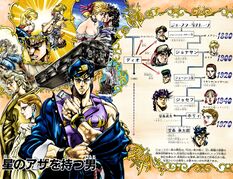
The first three parts complete Hirohiko Araki's initial vision for the series as a trilogy, but JoJo's Bizarre Adventure continued nonetheless after the end of the third part.[9][10]
Diamond is Unbreakable
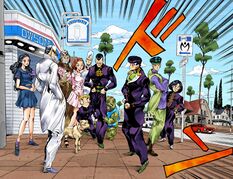
The fourth part, Diamond is Unbreakable, is set in the fictional town of Morioh, Japan, in 1999. It follows Joseph's illegitimate son Josuke Higashikata as he meets friends and enemies among a host of new Stand users created by the Bow and Arrow, the same items that gave DIO his Stand. He, Okuyasu Nijimura, Koichi Hirose, Jotaro Kujo, and Rohan Kishibe eventually find themselves hunting down the serial killer Yoshikage Kira.
Vento Aureo
In the fifth part, Vento Aureo, set in Italy in 2001, DIO's son Giorno Giovanna joins Passione, the most powerful gang in Italy, intending to overthrow the gang's mysterious boss in order to protect the civilian populace from the gang's drug trade. To do so, he cooperates with gang member Bruno Bucciarati and his own team of Leone Abbacchio, Guido Mista, Narancia Ghirga, and Pannacotta Fugo. The team are initially tasked with protecting the boss's daughter Trish Una from the traitorous La Squadra Esecuzioni, but eventually turn on the gang upon realizing that the boss intends to kill Trish to preserve his secrecy.
Stone Ocean
The sixth part, Stone Ocean, is set in 2011 as Jotaro's estranged daughter Jolyne Cujoh is framed for murder and imprisoned in Green Dolphin Street Prison. While attempting to break Jolyne out of prison, Jotaro has both his memories and Stand stolen by the Stand Whitesnake. Jolyne then decides to stay in prison in order to find out who Whitesnake's user is, save her father's life, and put a stop to Whitesnake's greater plot. Along her adventure, Jolyne gains allies in Emporio Alnino, Ermes Costello, Foo Fighters, Narciso Anasui, and Weather Report.
Second Continuity
Parts 7-9 take place in an alternate continuity from the events of Parts 1-6. In this second continuity, characters, locations, and concepts bearing similarities to those in the first continuity appear, but the Stand abilities and events surrounding them are drastically different. This continuity details the story of Johnny Joestar and his descendants, as well as the Saint's Corpse.
Though Araki has called the continuity of Parts 7-9 a continuation of the universe shown at the end of Part 6,[10][11] he has also stated that the settings of Diamond is Unbreakable and JoJolion are linked in neither space nor time,[12] and the relation between the continuities is treated as ambiguous in JOJOVELLER.[13]
Steel Ball Run
Set in 1890 in the United States, Steel Ball Run follows a race across the United States of America called the Steel Ball Run, named after its promoter, Steven Steel. Gyro Zeppeli, a master of the unique Spin technique seeking the cash prize, and Johnny Joestar, a paraplegic ex-jockey seeking to cure his legs through the Spin, decide to cooperate in order to win the race. The two soon discover that the race is a cover for President Funny Valentine's investigation of certain powerful and invaluable relics of Jesus Christ, and eventually find themselves chasing said relics while fending off Valentine's many government agents.
JoJolion
Leaping to 2011 in JoJolion, university student Yasuho Hirose discovers an amnesiac man tentatively named "Josuke" in Morioh after the (then-contemporary) Great East Japan Earthquake. The two decide to investigate Josuke's past identity, initially thought to be that of the ship doctor Yoshikage Kira, and the circumstances of his presence in town. Josuke is left in the care of the affluent Higashikata Family as he and Yasuho uncover the family's darkest secrets, including their ties to a mysterious race of humanoid beings and a certain fruit capable of breaking their familial curse.
The JOJOLands
On the volcanic islands of Hawaii sometime in the 2020s, The JOJOLands follows the story of Jodio Joestar, a high school student with antisocial personality disorder working as a gofer for a small gang managed by Meryl Mei Qi, along with Paco Laburantes and Usagi Alohaoe. After teaming up with Hawaii Island native Charming Man, the group sets out on a mission to steal the land where Charming Man's brother disappeared from a company named HOWLER, with the aid of a mysterious Lava Rock pilfered from Rohan Kishibe.
Parts
| No. | Title | Original Run | Chapters | Volumes | Image |
|---|---|---|---|---|---|
| 1 | 
|
1986 - 1987 | 44 | 5 | 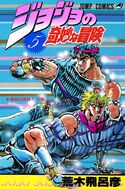
|
| Part 1, set in 1880s England, follows Jonathan Joestar as he matures with and eventually battles his adoptive brother, the cunning and merciless Dio Brando. | |||||
| 2 | 
|
1987 - 1989 | 69 | 7 | 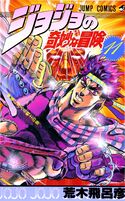
|
| Part 2, which takes place in 1938, follows Jonathan's grandson Joseph Joestar as he finds himself embroiled in a war against the Pillar Men, ancient super-beings and the creators of the Stone Mask. | |||||
| 3 | 
|
1989 - 1992 | 152 | 16 | 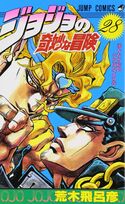
|
| In Part 3, set in 1988, Joseph's grandson Jotaro Kujo and his allies, all equipped with the power of a Stand, journey from Tokyo to Cairo to save Jotaro's mother's life and defeat his family's arch-nemesis, DIO. | |||||
| 4 | 
|
1992 - 1995 | 174 | 18 | 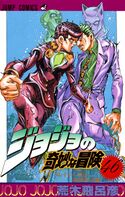
|
| Part 4, set in 1999 in the fictional town of Morioh, sees Joseph's bastard son Josuke Higashikata and his friends seek out mysterious Arrows with the power to bestow Stand abilities, as well as the serial killer Yoshikage Kira. | |||||
| 5 | 
|
1995 - 1999 | 155 | 17 | 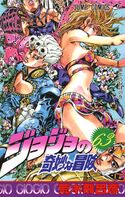
|
| Part 5, set in Italy in 2001, follows DIO's son Giorno Giovanna, who aims to rise within the Italian mafia by subverting the dominant gang Passione and its mysterious boss with the aid of a team of fellow Stand users. | |||||
| 6 | 
|
1999 - 2003 | 158 | 17 | 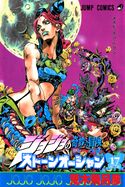
|
| In Part 6, which takes place in 2011, Jotaro's daughter Jolyne Cujoh is framed for murder and thrown in Florida's Green Dolphin Street Prison, where she and her allies struggle to discover who had her imprisoned and what they hope to achieve. | |||||
| 7 | 
|
2004 - 2011 | 95 | 24 | 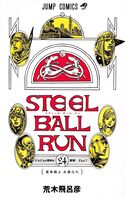
|
| Set in the 1890 of a new continuity, Part 7 follows Gyro Zeppeli, master of a mystic art named the Spin, and Johnny Joestar, a paraplegic ex-jockey. They compete in the Steel Ball Run trans-American race, but find themselves targeted after uncovering its benefactor's true motivation. | |||||
| 8 | 
|
2011 - 2021 | 110 | 27 | 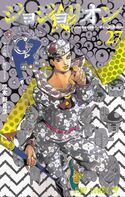
|
| The Steel Ball Run continuity continues in 2011 with Part 8, as Yasuho Hirose unearths an amnesiac young man tentatively named Josuke Higashikata near Morioh. The two set out to uncover his identity, and are ultimately caught up in a battle against an inhuman race over a fruit that can break curses. | |||||
| 9 | 2023–Present | Ongoing | Ongoing | 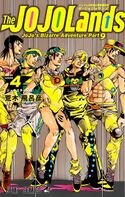
| |
| On the volcanic islands of Hawaii, Part 9 follows small-time gang members Jodio and Dragona Joestar. After acquiring a peculiar rock during a heist, Jodio's dream of striking it rich begins to become a reality. | |||||
Publication
Chapters are serialized in Weekly Shonen Jump and Ultra Jump, under Shueisha. While in Weekly Shonen Jump, the series was published under the tagline "Romance Horror! -A Crimson Tale-" (ロマンホラー!—深紅の秘伝説—, Romanhorā!-Shinku no hi densetsu-). The tagline was created by the editorial department at Shueisha and was included in every chapter up until Stone Ocean.
International Publication
In North America and the United Kingdom, Stardust Crusaders was translated into English and published in 16 volumes by VIZ Media from November 8, 2005 to December 7, 2010 under the title of JoJo's Bizarre Adventure, skipping both Phantom Blood and Battle Tendency. On June 9, 2014, VIZ Media published the first three parts of JoJo's Bizarre Adventure from the JoJonium line of manga, from February 24, 2015 to February 5, 2019, marking the first English publications of Phantom Blood and Battle Tendency. On July 6, 2018, VIZ Media announced they would be releasing an English publication of Diamond is Unbreakable. The first volume of Diamond is Unbreakable was released on May 7, 2019, and finished on May 4, 2021. On August 3, 2021, VIZ Media released the first volume of Vento Aureo in English. On February 3, 2023, VIZ Media announced they would be releasing an English publication of Stone Ocean in fall of that year.
In Italy, Star Comics began publishing the series in a monthly format under the title Le bizzarre avventure di JoJo from November 1993 to April 2004.[14] These monthly releases contained around five chapters in each trade paperback, with 126 paperback volumes released for the first six parts. Starting with Steel Ball Run, published from March 2006 to February 2012, new volumes are published in the Japanese (tankōbon) format. In 2010 Star Comics began publishing the Bunko Edition, completely replacing the original releases of the first 7 parts. Having completely released JoJolion (February 2014-July 2022) and the JoJonium release of Parts 1-3 (October 2019-May 2022), they are up to date with the series as of December 2022.
In France, the first four parts were published by J'ai lu[15] from January 2002 to December 2005. In 2007, publisher Tonkam (now a subsidiary of Delcourt) resumed the publication of the following parts starting with a publication of Vento Aureo. The previous parts would later see revised releases under Tonkam's publication, starting with Stardust Crusaders before going back to Phantom Blood and continuing from there. Currently, they are publishing JoJolion.[16]
In Taiwan, JoJo was illegally distributed under the title Strongman Front (強人陣線) by Tong Li Comics for many years until Daran Comics obtained the official publishing license for JoJo, renaming the comic to JoJo Adventure Wild (JoJo冒險野郎). On March 31, 2003 Daran Comics shut down their offices and the license for JoJo was officially obtained by Tong Li Comics, who now officially distributes the series under the original title of JoJo's Bizarre Adventure (JoJo的奇妙冒險). In Hong Kong, the publisher of the series is World Publishing Limited under the label Comics World, who have published all of JoJolion.[17][18] In China, the series is distributed digitally by Bilibili Comics, who have published the entire series; they are currently publishing The JOJOLands in simultaneous release with the Japanese edition.[19]
Making-Of
When he first conceived JoJo's Bizarre Adventure, Araki was throwing around several core ideas he wanted to portray such as an idea of succession between generations, but also to show traveling heroes. From there he began to set up his ideas for Phantom Blood. Araki notes that the process of creating JoJo went from fight to a more spiritual aspect, and that concepts like friendships took a greater place over time.[20] Araki had several themes in mind too, such as the idea of "mystery",[21] and notably the mystery coming from bloodlines. He also asked himself "Who is the strongest person in the world?" and derived from this question themes such as immortality, seeking life, or justice.[21] More importantly, Araki felt that he could create something unique among the current series at Weekly Shonen Jump with these ideas. Araki had initially only planned for three parts,[22] but decided to continue with his series.
Writing JoJo
Araki gives precedence to emotion and inner thought over plot structure, trying to portray the protagonists' destiny.[21]
Araki follows a particular narrative style called the "golden road", characterized by strong and determined protagonists who constantly advance towards their objectives. This "golden road" is, according to him, the best way to draw in the audience. One example of his "golden road" is the plot of Stardust Crusaders during which the heroes always manage to defeat the enemies on their paths and inexorably approach Egypt. Araki is not avert to killing off his protagonists like Jonathan Joestar but feels that if the death served a greater purpose then he still abides by the "golden road".[23] Araki thinks the basic plot of his parts around a particular predicament and likes to throw his protagonist quickly into said predicament before continuing off his story from there (e.g. Johnny Joestar is paraplegic and wants to find a way to heal his legs).[23] Araki also use a rather original plot structure for the series. Instead of the classical "tournament" format of most other series at the time where the heroes fought enemies in a predictable increasing order of strength, Araki adopted a sugoroku style (sugoroku is a table-top game similar to snakes and ladders) where the heroes would travel and then meet enemies at particular points in said journey and the fights would be more varied due to a better variety of powers, and an emphasis on wit rather than force.[24] Araki also denounces the long-term limitations of always increasing the strength of enemies in a serialized manga.[21][25]
Araki takes inspiration from a variety of sources to write his series. He has confirmed several times that he uses Western music to name his characters, but also copies designs from varied sources such as artbooks, comic books, the news, or movies. Araki extensively uses books rather than online research.[26] One lesser known aspect of his research is that he often travels to the places he depicts in the series in order to have a better feeling of the place and gather details that an online research wouldn't give. His first tanto Ryosuke Kabashima encouraged him to see movies for inspiration and also travel.[27] Kabashima notably coerced Araki into traveling to Egypt to later depict it in Stardust Crusaders.[28] Araki would later on keep this habit and went to Italy for Vento Aureo[29] and went to a correctional facility in Florida too to get inspiration for Green Dolphin Street Prison,[30][31] as well as Orlando.[32] He also went on several long journeys in the USA and Japan to better write Steel Ball Run too.[33] His habit of traveling to research places extended to individual buildings such as a hospital or a drug store.[34]
Araki makes it a point to never rest on his laurels and always find new ideas. For instance, Araki was displeased to think he had reached a summit with Stone Ocean in terms of idea and had decided to erase the original continuity and revisit his old ideas in a second continuity.[35] His will to always change is also notable on his art (though he explains it as avoiding drawing old art rather than deliberately change).[36] Araki's art style has changed considerably over the years, although he had always kept core ideas about his art such as his dramatic poses and representation of an ideal human body. For instance, muscle-bound heroes were popular in the 80s so Araki drew these types of characters (e.g. Jonathan), but as trend changes, Araki transitioned to more normal-looking characters like Giorno, a slimmer pretty boy character type.[20][37] The unusual sound effects Araki inserts in his page are inspired from horror movies and rock music, akin to scare chords and other noises produced by synthetizers and mellotrons.[37] More specifically, the music which plays in a scene where a woman gets stabbed in Alfred Hitchcock's Psycho inspired Araki to try and express the same sense of "impending danger" using sound effects in his manga.[38]
During its publication in the Weekly Shonen Jump magazine, Araki continuously tried to push for unique ideas, often infringing on what was considered acceptable for the magazine. Araki notably decided to make his first protagonist a foreigner and then kill him off to replace him, which was a taboo. Araki also had tried to write female protagonists for the series, with notably Giorno Giovanna being initially thought as a young woman. This would be eventually portrayed with Jolyne Cujoh, whose sex he insisted on despite his editor's requests. Araki notably thought that it was then acceptable to portray women being subjected to violence as intense as male characters were being exposed to.[37][39] It led to several conflict with the editorial team who tried to tone down the violence and themes Araki wanted to write about.[40]
When Araki creates a character, he thoroughly completes a datasheet about said character, which includes their physical characteristics, their tastes, and background information like a potential family.[41] Araki notes that his habit of naming characters after bands and albums is a simple hobby, and a way to pay his respect to the musicians he likes.[21]During his time at the Weekly Shonen Jump, Araki had the following schedule: Sundays were spent finding ideas, Mondays were spent making the draft storyboard for the chapter. He then met with his editor and began drawing more elaborate sketches, one page at a time. Tuesdays, Wednesdays and Thursdays were spent finishing drawing the chapter for the publication of the Weekly Shonen Jump magazine, and Fridays and Saturdays were spent resting.[42] This schedule that Araki followed strictly was set up by Kabashima too.[27] This notably allowed Araki to keep in shape, and he was also noted as being always on time for his chapters.[43] His currently monthly schedule seems to have stayed the same as his weekly schedule, with Fridays and Saturdays off. Araki adds that he wakes up at 10 AM, begins working at 11 AM, takes a break at noon, and finishes his work day at Midnight.[44] Araki says that his current 45 pages a month matches his natural pace better.[26] Thanks to his strict schedule, Araki has never missed a deadline in his career.[26][43]
References
- ↑ Baoh: The Visitor Issue #1 English Author's Note
- ↑ https://www.viz.com/jojo-s-bizarre-adventure Official Website for JoJo's Bizarre Adventure
- ↑ Note: The official anniversary of the series is celebrated on January 1, 1987.
- ↑ My Rohan Kishibe Talk - "JoJo's Bizarre Adventure Has Printed 120,000,000 Copies". JoJo-News. December 18, 2021.
- ↑ Morioh Map (JoJolion)
- ↑ [Question for Araki-sensei! (13): "If you can describe JoJo in a single word"] - comipress.com, 2007
- ↑ [Question for Araki-sensei! (9): "If You Can Describe Manga in A Single Word"] - comipress.com, 2007
- ↑ Note: The timeframe of Stardust Crusaders is originally stated to be 1987-1988 before later being changed to 1988-1989 in both the manga and anime.
- ↑ JoJonium Volume 8 (Jotaro Kujo) - Special Interview
- ↑ 10.0 10.1 Interview:JoJo Could Have Ended with Part 4 (October 2012)
- ↑ Interview:Aomaru Jump (February 2004)
- ↑ Interview:All-Star Battle's Guidebook (August 2013)
- ↑ Interview:JOJO JOURNEY (September 2013)
- ↑ Le bizzarre avventure di JoJo First Italian release November 1993
- ↑ J'ai lu
- ↑ Hirohiko Araki - Delcourt
- ↑ Comic World's Facebook post on JoJolion 27
- ↑ JoJo的奇妙冒险 Chinese Wikipedia page for the JoJo series
- ↑ 乔乔的奇妙冒险 第9部 The JOJO Lands - 哔哩哔哩漫画
- ↑ 20.0 20.1 Animeland Interview 06/2003
- ↑ 21.0 21.1 21.2 21.3 21.4 Tokai Lecture 06/2006
- ↑ Weekly Shonen Bracket 100Q
- ↑ 23.0 23.1 Hirohiko Araki's Manga Techniques chapter 4
- ↑ NYT Japan interview 11/2018
- ↑ Volume 45, Volume 46 Author's note
- ↑ 26.0 26.1 26.2 Dream Talk Sessions 2013
- ↑ 27.0 27.1 JOJOVELLER History 1979-2013
- ↑ Manga Heaven 06/2007
- ↑ Volume 48 Author's note
- ↑ SO Volume 1 special thanks
- ↑ SO Volume 5 Author's Note
- ↑ SO Volume 12 Author's Note
- ↑ P7 Bunko 1 afterword
- ↑ Volume 41 Author's Note
- ↑ P6 Bunko Vol.11 Afterwords
- ↑ JOJOmenon interview
- ↑ 37.0 37.1 37.2 Phantom Blood PS2 Game interview
- ↑ Mainichi Shimbun interview
- ↑ P6 Bunko Vol.1 Afterwords
- ↑ P5 Bunko Vol.1
- ↑ Manga in Theory and Practice chapter 3
- ↑ JoJo 6251 Araki interviews
- ↑ 43.0 43.1 JOJOVELLER 2013 Azuma interview
- ↑ Asahi Shimbun interview
